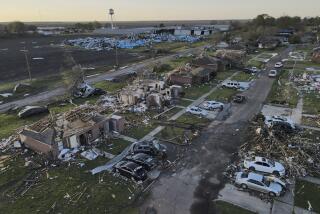Louisiana Hamlet Acts as Temporal Resting Place
- Share via
ST. GABRIEL, La. — This small town is known for prisons, a former leprosy hospital and so many chemical plants that some dub the area “cancer alley.”
Now it is temporary host to the dead.
Nearly 800 victims of Hurricane Katrina are being housed here in the makeshift morgue established by the Federal Emergency Management Agency and Louisiana officials, as experts work to identify bodies shipped in from around the state.
At the heavily secured compound, a chain-link fence wrapped in black plastic surrounds a 125,000-square-foot warehouse, and two tents and a fleet of 18-wheelers sit in the parking lot.
The dishwater-colored corrugated-metal building looms at the end of a quiet residential street where small one-story brick houses rest in patches of lawn.
Some locals aren’t thrilled with the bodies in their midst.
“If the generator or whatever they got in there goes out, [they’re] going to start stinking,” said Anna Hunter, 57, a homemaker whose trailer is within view of the morgue. “What are we supposed to do?”
Mayor George Grace assured residents at a town meeting early last month that the bodies arriving by big rig posed no health risks. The business of the Town Hall, housed in an old school building inside the complex, rolls on -- although residents have to pass through a guarded checkpoint to pay their utility bills.
The bodies are decontaminated, then placed in cold storage before and after Disaster Mortuary Operational Response Team members gather forensic data for identification. Hazards are “as close to nonexistent as [they] can be,” said Don Kelly, spokesman for the response team’s Louisiana operation.
The town was a good fit because it had enough available space and it’s just 17 miles south of Baton Rouge and about 70 miles northwest of New Orleans, Kelly said.
Many residents of this working-class city of 5,500 at the edge of the Mississippi River take a charitable view of the morbid media spotlight focused their way.
“Everybody wants to make sure their family gets a proper burial,” said Melvin Thomas, 56, a retired chemical plant operator who raises racehorses on his three-acre property and has lived in town for 24 years. “If that was some of my family members, that’s what I’d want.”
Plus, Thomas added, “it had to be somewhere.”
National attention and 200-some federal workers camped at the site have made waves in St. Gabriel, made up of a handful of streets and buildings miles from any interstate and clustered next to sugar-cane crops and hayfields.
Nearly a quarter of the town’s residents live below the poverty line, according to census data; St. Gabriel’s median household income in 2000 was $25,352, compared with nearly $42,000 nationwide.
Foot traffic at the post office in the Sunshine neighborhood has gone up, said Postmaster Relief Angela Banta, 26. Some FEMA folks stop by just to take snapshots of the tiny office, housed in a trailer.
Durss Wilson doesn’t mind the rumble of 18-wheelers nor the roar of helicopters headed to the morgue, which abuts his backyard. The federal workers who jog by his place often stop to feed apples to his five horses, said Wilson, 52, who works loading goods at the St. Gabriel Hardware store.
Traffic has increased incrementally, and occasionally people come through town looking to reclaim a lost loved one, Grace said.
But in a city with two state prisons -- now jammed with inmates from New Orleans -- and a former leprosy hospital in the nearby village of Carville, locals take the new addition to their community in stride, Grace said.
“We just have a history of accommodating people that other people don’t accommodate,” Grace said.
Usually most of the action in town is found either at the truck stop, with a casino and restaurant advertising the “world’s best catfish”, or at the 115-year-old grocery store and deli, where you can buy Zapp’s Cajun Dill Gator-Tator chips, extension cords and $1 longneck beers.
“A majority of the people feel compassionate for the ones who lost everything in the storm,” said St. Gabriel Police Chief Kevin Ambeau, who estimates the morgue could be in town for as long as a year. “They’d rather see them here than floating on the interstate or tied to a stop sign in New Orleans.
“This is a national disaster, and St. Gabriel is playing a very small part in it. It just happens to be the final chapter.”
More to Read
Sign up for Essential California
The most important California stories and recommendations in your inbox every morning.
You may occasionally receive promotional content from the Los Angeles Times.













